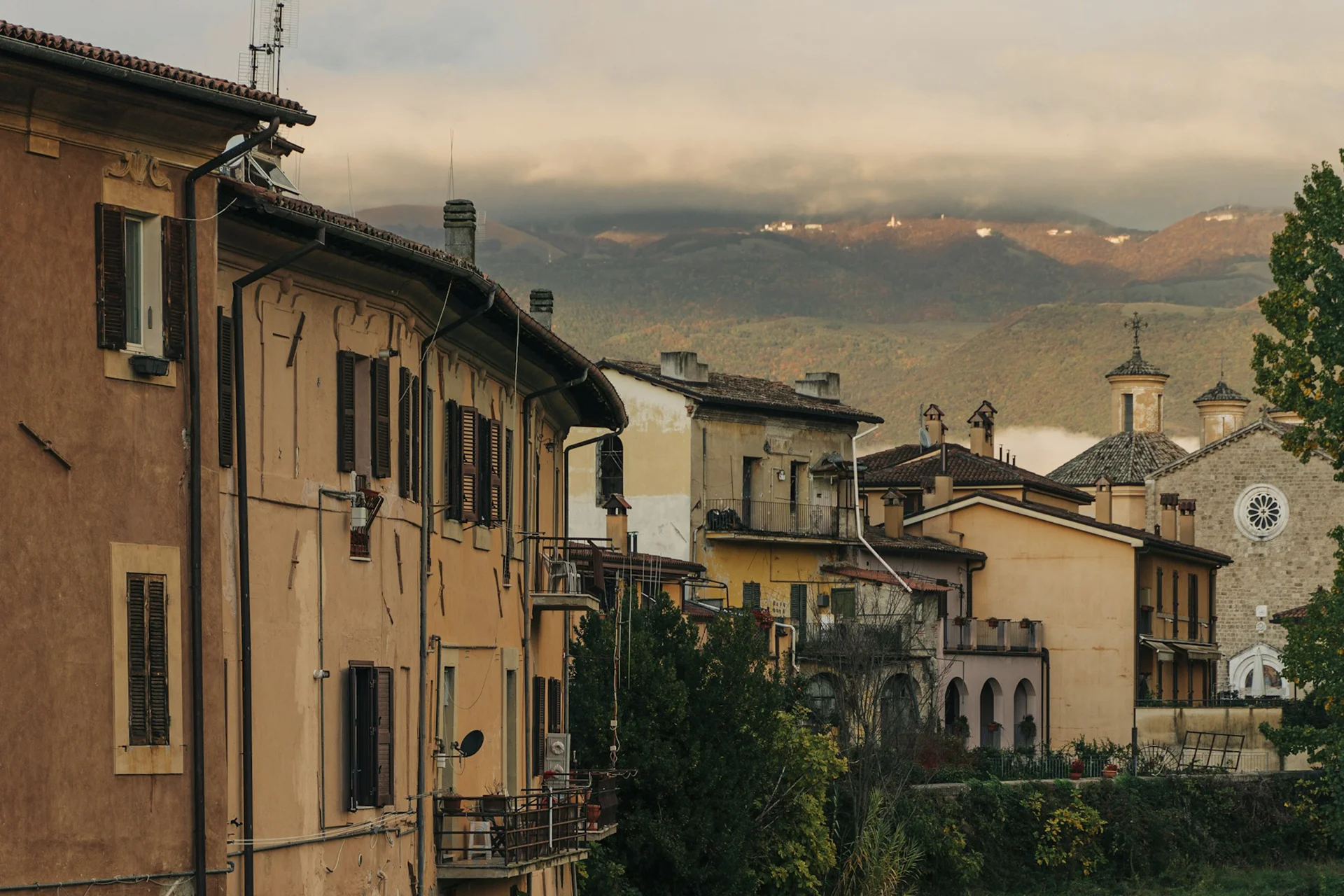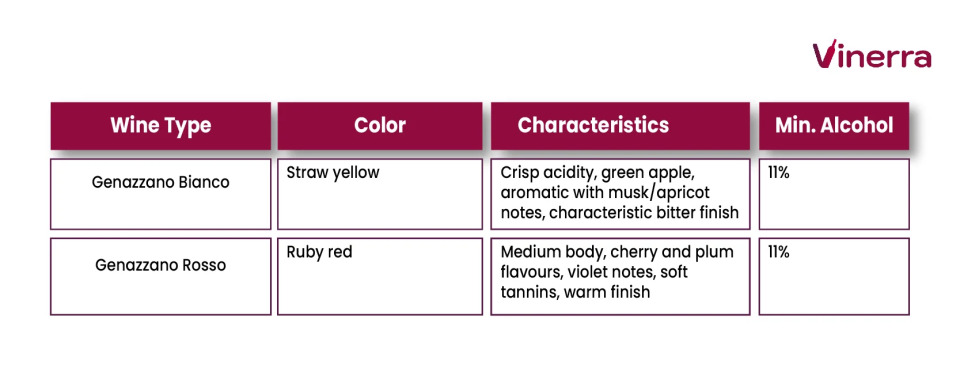
LATITUDE
LONGITUDE
APPELATIONS
Think of Genazzano DOC as the underdog story Italian wine desperately needs. While tourists stumble through Frascati with white wines that taste like sadness in a carafe, Genazzano sits 45 kilometres east of Rome on the southern slopes of the Monti Prenestini, quietly making wines that deserve your attention.
This isn't another tale of international grapes conquering Italian terroir; it's about Ciliegiolo and Malvasia Bianca di Candia holding their ground on volcanic soil that's been nurturing vines since before Caesar's legions marched past.
This profile covers everything from the DOC's medieval winemaking origins to its current sustainability efforts, the terroir that shapes its character, and why two local wineries are betting on grapes most sommeliers can't pronounce.
Genazzano DOC occupies a small but distinctive corner of Lazio's wine landscape. The appellation sits at 375 meters (1,230 feet) above sea level on a tuff spur overlooking the Valle del Sacco. The zone encompasses municipalities in the provinces of Rome and Frosinone, including the town of Genazzano itself. This medieval settlement once served as a vacation resort for ancient Roman aristocrats. The province of Rome includes the municipalities of:
Genazzano, Cave, Olevano Romano and San Vito Romano, further highlighting the area's rich cultural and geographical diversity.
Here's what makes this place different: while neighbouring Castelli Romani DOC churns out industrial volumes, Genazzano has remained stubbornly small-scale. The DOC classification, established in 1992 and revised in 2011, produces both red and white wines under strict varietal requirements that essentially compel winemakers to showcase indigenous grapes or face consequences.
.jpg)
Those numbers aren't typos. Genazzano DOC is genuinely tiny — roughly the size of a Manhattan city block dedicated to viticulture. This isn't a bug; it's a feature. Small production means wineries can focus on quality over quantity, though it also means you won't find these bottles at your local supermarket.
Genazzano's wine history reads like a greatest hits album of Italian civilization. The area has produced wine for a long time, more specifically, since pre-Roman times, when it likely served as a garrison town. During the Middle Ages, the town gained a reputation throughout the region for its wines, competing directly with neighbouring zones to supply Rome's insatiable thirst.
The modern DOC was established in June 1991 (formalized in 1992) to protect local winemaking traditions. A critical revision in July 2010 (enacted in 2011) tightened grape variety restrictions and raised quality standards. This wasn't just bureaucratic paperwork — it was a declaration that Genazzano would prioritize authenticity over commercial expedience. The DOC essentially told international varieties to take a hike, doubling down on Ciliegiolo and Malvasia instead.
Today, these efforts are paying off, and we are seeing a renaissance of this region.

Vineyard Hectares
WINERIES
GROWING DEGREE DAYS
Genazzano extends along the southern slopes of the Monti Prenestini, where the mountain range (peaking at Monte Guadagnolo, at 1,218 meters / 3,996 feet) creates a natural amphitheatre overlooking the Sacco River valley. The vineyards benefit from southeastern exposure, capturing morning sunshine while avoiding the harshest afternoon heat.
The region experiences a Mediterranean climate, with continental influences at higher altitudes. Summer temperatures reach 30°C (86°F), while winters remain mild at 8–12°C (46–54°F). The area receives approximately 750 mm (29.5 inches) of annual precipitation, concentrated in autumn and winter months, with dry summers that promote grape ripening while minimizing disease pressure.
Diurnal temperature variation, the difference between day and night temperatures, is significant here due to elevation. This allows grapes to develop phenolic ripeness during warm days while retaining crucial acidity during cool nights.
The volcanic origins of Lazio's landscape define Genazzano's terroir. The soils are predominantly volcanic in origin: tuff, potassium-rich volcanic deposits, and mineral-laden substrates left by ancient eruptions. These porous, well-draining soils force vine roots to dig deep for water and nutrients, creating natural stress that concentrates flavours and produces smaller, more intense berries.
Think of it this way: volcanic soil is like sending your vines to boot camp — they struggle, they suffer, and they emerge producing grapes with character you can't fake.
In Genazzano DOC wines, indigenous varieties take center stage. For red wines, the main grape variety is Ciliegiolo, which must have a minimum concentration of 85%. On the other hand, for white wines, the main grape variety is Malvasia Bianca di Candia.


The main wine styles of the region are Genazzano Bianco and Genazzano Rosso, both blends with unique characteristics. Genazzano Bianco is notable for its straw-yellow colour with greenish reflections, which hint at its freshness and vibrant profile.

Both styles range from dry to sweetish, offering versatility for different occasions and food pairings. The DOC white wines showcase the volcanic terroir through mineral salinity, while reds emphasize fruit purity and approachability.
Genazzano offers more than wine. The medieval village features the Castello Colonna (once home to Pope Martin V), the Renaissance Ninfeo del Bramante, a stunning nymphaeum designed by Bramante for the Colonna family, and the Sanctuary of Our Lady of Good Counsel, which houses a miraculous fresco that drew the devotion of Pope Leo XIII.
The town’s annual Infiorata del Sacro Cuore festival (held on the first Sunday of July since 1883) creates elaborate petal mosaics covering 1,642 square meters, a Guinness World Record holder. Wine tourists can combine vineyard visits with Renaissance architecture, medieval history, and cultural festivals that bring the region to life.
In addition to visiting them, make sure to follow them on their social media pages to learn more about their connection to the land. You can also visit the wineries' official websites for detailed information on tours and wine offerings.
Genazzano has two main wineries, each recognized by many reviews of wine experts: Nuova Cantina Sociale di Genazzano and Vinicola Schiavella.
Schiavella produces Genazzano DOC whites alongside innovative products such as a rosé spumante brut made from Cesanese, showcasing the versatility of local grapes. The winery marries traditional agricultural practices with modern technology, creating wines that honour the past while embracing the future.
Lazio is experiencing a sustainability revolution, and Genazzano producers are taking action to respond to climate change. The region's natural wine producers are investing in organic and biodynamic viticulture, reviving traditions like aging wine in chestnut barrels, and emphasizing minimal intervention winemaking.
Both Nuova Cantina Sociale di Genazzano and Vinicola Schiavella adopt environmentally respectful practices. This includes reducing chemical inputs, preserving soil health, promoting biodiversity, and maintaining short supply chains that minimize environmental impact while supporting local economies.
The broader Lazio wine industry is certified under programs such as Ecocert (organic) and Demeter (biodynamic), as well as regional sustainability certifications like HVE (High Environmental Value). These certifications require rigorous standards:
Genazzano's small-scale operations naturally support sustainability: hand-harvesting, limited mechanization, and family-run practices create wines with lower carbon footprints than industrial alternatives. The volcanic soils' natural resistance to phylloxera has helped preserve ungrafted vines and Italy's unparalleled collection of indigenous varieties.